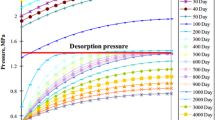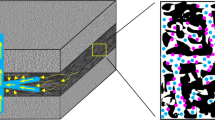Abstract
Coal-bed methane (CBM) is a precious clean energy. A reasonable well type and pattern design is the premise and the key to effective development of coal-bed methane. In this paper, a set of optimization method is presented which includes a fine CBM numerical model with the combina tion of the isothermal adsorption test results. Different Langmuir curves and adsorption–desorption time are corresponding to different grids in the model. The model has advantages over previous models in terms of the CBM reservoir structural characteristics and permeability anisotropy. As in most of CBM mining area, the structural characteristics are so complex that a combination of vertical and U-shaped wells is the best choice to achieve optimum production of gas. To optimize the pattern and spacing between vertical wells, different types of coal-bed cleats pressure drop rules are in consideration. Based on the CBM content in the reservoir, the distribution of different well types can be determined. The optimization method above has been applied in one pilot area in QinDuan Block, China. The result shows that combination of U-shaped and vertical wells in a diamond well pattern will provide the best CBM production scenario. In this diamond well pattern, the optimum well spacing along the long and short diagonals is 350 and 300 m, respectively. The degree of reserve recovery was predicted to up to 56.63 % after 30 years of production.




















Similar content being viewed by others
Abbreviations
- Q L :
-
Theoretical adsorption (m3/day)
- P :
-
Coal-bed reservoir pressure (MPa)
- V L :
-
Langmuir volume (m3/day)
- P L :
-
Langmuir pressure (MPa)
- V m :
-
Gas adsorption concentration in unit mass of coal matrix (m3)
- V E :
-
Equilibrium adsorption concentration of gas in unit mass of coal matrix (m3)
- \(\tau_{\text{p}}\) :
-
Adsorption time (day)
- G c :
-
CBM content at underground conditions (–)
- G co :
-
CBM content at laboratory conditions (–)
- A :
-
Ash content in the coal-bed reservoir (–)
- M :
-
Moisture content in the coal-bed reservoir (–)
- k x :
-
Permeability in the face cleat direction (×10−3μm2)
- k y :
-
Permeability in the butt cleat direction (×10−3μm2)
- \(\overline{k}\) :
-
Equivalent permeability after coordinate conversion (×10−3μm2)
- L f :
-
Half fracture length (m)
- L f0 :
-
Equivalent half fracture length after coordinate conversion (m)
- D x :
-
Well spacing in the long side direction of the rectangular well pattern or the long diagonal of the diamond well pattern (m)
- D y :
-
Well spacing in the short side direction of the rectangular well pattern or the short diagonal of the diamond well pattern (m)
References
Airey EM (1968) Gas emission from broken coal: an experimentation and theoretical investigation. Int J Rock Mech Min Sci 15:475–494
Amini S, Mohaghegh SD, Gaskari R, Bromhal G (2014) Pattern recognition and data-driven anyalytics for fast and accurate replication of complex numerical reservoir models at the grid block level: SPE167897
Bai MX, Sun JP, Song KP, Reinicke KM, Teodoriu C (2015a) Evaluation of mechanical well integrity during CO2 underground storage. Environ Earth Sci. doi:10.1007/s12665-015-4157-5
Bai MX, Sun JP, Song KP, Reinicke KM, Teodoriu C (2015b) Risk assessment of abandoned wells affected by CO2. Environ Earth Sci. doi:10.1007/s12665-015-4163-7
Baker MA, Mazumder S, Sharma H, Philopt LA, Scott MA, Wittemeier R (2012) Well design and well spacing optimization in unconventional plays. Soc Pet Eng. doi:10.2118/159325-MS
Blasingame TA (2008) The characteristic flow behavior of low-permeability reservoir systems: SPE114168
Boulis A, Jayakumar R, Rai RR (2013) A new approach for well spacing optimisation and its application to various shale gas rescources. Int Pet Technol Conf. doi:10.2523/17150-MS
Brennen CE (1995) Cavitation bubble dynamics. Oxford University Press, Oxford 20:48–53
Centilmen A, Ertekin T, Grader A (1999) Applications of neural networks in multiwall field development: SPE56433
Chen J, Qin Y, Fu X (2006) Simulation on dynamic variation of the permeability of high rank coal reservoirs during gas recovery, China. J China Univ Min Tech 1:49–53
Cipolla CL, Lolon EP, Erdle JC, Rubin B (2010) Reservoir modeling in shale-gas reservoirs. SPE Reserv Eval Eng 8:638–653
Connell LD, Lu M, Pan Z (2010) An analytical coal permeability model for tri-axial strain and stress conditions. Int J Coal Geol 84(2):103–114
Ekrem O (2009) Modeling of coal bed methane (CBM) production and CO2 sequestration in coal seams. Int J Coal Geol 77(2):145–152
Ghasemi M, Ibrahim A, Gildin E (2014) Reduced order modeling in reservoir simulation using the bilinear approximation techniques: SPE169357
Gou Y, Zhou L, Zhao X, Hou ZM, Were P (2015) Numerical study on hydraulic fracturing in different types of georeservoirs with consideration of H2 M-coupled leak-off effects. Environ Earth Sci. doi:10.1007/s12665-015-4112-5
Gray I (1987) Reservoir engineering in coal seams: Part 1—the physical process of gas storage and movement in coal seams. SPE Reserv Eng 2(1):28–34
Guo P, Cheng Y (2013) Permeability prediction in deep coal seam: a case study on the No. 3 coal seam of the southern Qinshui Basin in China. Scientific World J. doi:10.1155/2013/161457
Guo L, Li XZ, Zhou YY, Zhang YS (2015) Generation and verification of three-dimensional network of fractured rock masses stochastic discontinuities based on digitalization. Environ Earth Sci. doi:10.1007/s12665-015-4175-3
Jin WC, Gao MZ, Yu B, Zhang R, Xie J, Qiu ZQ (2015) Elliptical fracture network modeling with validation in datong mine. Environ Earth Sci, China. doi:10.1007/s12665-015-4158-4
Kang HP, Zhang X, Si LP (2010) In-situ stress measurements and stress distribution characteristics in underground coal mines in China. Eng Geol 116(3):333–345
Li MT, Gou Y, Hou ZM, Were P (2015) Investigation of a new HDR system with horizontal wells and multiple fractures using the coupled wellbore–reservoir simulator TOUGH2MP-WELL/EOS3. Environ Earth Sci. doi:10.1007/s12665-015-4242-9
Lin BQ, Shen CM (2015) Coal permeability-improving mechanism of multilevel slotting by water jet and application in coal mine gas extraction. Environ Earth Sci. doi:10.1007/s12665-015-4154-8
Liu J, Chen Z, Elsworth D (2011) Interactions of multiple processes during CBM extraction: a critical review. Int J Coal Geol 87(3):175–189
Liu XH, Dai F, Zhang R, Liu JF (2015) Static and dynamic uniaxial compression tests on coal rock considering the bedding directivity. Environ Earth Sci. doi:10.1007/s12665-015-4106-3
Mark AB, Saikat M and Himanshu S (2012) Well design and well spacing optimization in unconventional plays: SPE159325
Meehan DN, Horne RN, Aziz K (1988) Effect of reservoir heterogeneity and fracture azimuth on optimization of fracture length and well spacing. Soc Pet Eng. doi:10.2118/17606-MS
Mirzabozorg A, Nghiem L, Chen Z, Yang C (2013) Differential evolution for assisted history matching process: SAGD case study: SPE165491
Mohaghegh SD (2014) Converting detail reservoir simulation models into effective reservoir management tools using SRMS case study-three fieds in Saudi Arabia. Int J Oil Gas Coal Technol 7(2):115–131
Muskat M (1940) Principles of well spacing. Soc Pet Eng. doi:10.2118/940037-G
Okano H (2013) Reservoir model history-matching and uncertainty quantification in reservoir performance forecast using bayesian framework: SPE165970
Onwunalu JE, Litvak M, Durlofsky LJ, Aziz K (2008) Applications of statistical proxies to speed up field development optimization procedures: SPE117323
Palmer I, Mansoori J (1998) How permeability depends on stress and pore pressure in coalbeds: a new model. SPE Reserv Eval Eng 1(6):539–544
Peter JC, Beamish BB, Marjorie V (1998) Coalbed methane sorption related to coal composition. Int J Coal Geol 35(4):147–158
Price HS, McCulloch RC (1973) A computer model study of methane migration in coalbeds. The Can Min Metall Bull 66:103–112
Robertson EP, Christiansen RL (2005) Modeling permeability in coal using corption-induced strain data: SPE97068
Sahai V, Jackson G, Rai RR, Coble L (2012) Optimal well spacing configurations for unconventional gas reservoirs. Soc Pet Eng. doi:10.2118/155751-MS
Sarma P, Chen WH (2008) Efficient well placement optimization with gradient-based algorithms and adjoint models: SPE112257
Shi J, Li X, Zhang D, Li Q, Hu S, Wu K (2012) Optimization of well pattern in the development of coalbed methane through vertical wells, China. Coal Geol Explor 2:28–30
Thararoop P, Karpyn ZT, Ertekin T (2012) Development of a multi-mechanistic, dual-porosity, dual-permeability, numerical flow model for coalbed methane reservoirs. J Nat Gas Sci Eng 8:121–131
Thotsaphon C, Chen H and Lawrence WT (2001) Impacts of permeability anisotropy and pressure on coalbed methane (CBM) production: SPE71069
Vlemmix S, Joosten GJP, Brouwer DR, Janse JD (2009) Adjoint-based well trajectory in a thin oil rim: SPE121891
Wang L, Cheng YP, Wang L, Guo PK, Li W (2012) Safety line method for the prediction of deep coal-seam gas pressure and its application in coal mines. Saf Sci 50(3):523–529
Wang L, Liu JF, Pei JL, Xu HN, Bian Y (2015) Mechanical and permeability characteristics of rock under hydro-mechanical coupling conditions. Environ Earth Sci. doi:10.1007/s12665-015-4190-4
Wattenbarger RA, El-banbi AH, Villegas ME (1998) Production analysis of linear flow into fractured tight gas wells: SPE39931
Wu YS (2002) Numerical simulation of single-phase and multiphase non-Darcy flow in porous and fractured reservoirs. Transp Porous Media 49(2):209–240
Xie HP, Xie J, Gao MZ, Zhang R, Zhou HW, Gao F, Zhang ZT (2015a) Theoretical and experimental validation of mining-enhanced permeability for simultaneous exploitation of coal and gas. Environ Earth Sci. doi:10.1007/s12665-015-4113-4
Xie LZ, Gao C, Ren L, Li CB (2015b) Numerical investigation of geometrical and hydraulic properties in a single rock fracture during shear displacement with the Navier-Stokes equations. Environ Earth Sci. doi:10.1007/s12665-015-4256-3
Xu B, Li X, Shao C, Chen D, Huang Y, Hu X (2011) Determination methods of well pattern and spacing for coalbed methane reservoir considering hydraulic fractures, China. Coal Geol Explor 4:16–19
Xu B, Li X, Ren W, Du X, Wen S, Chen D (2014) Optimization model of well pattern and spacing in CBM reservoirs using the concept of balanced depressurization, China. J China Univ Min Technol 1:88–93
Yang X, Ye J (2008) Well pattern optimization design for CBM development, China. Coalbed Methane 1:13–17
Zhang H, Liu J, Elsworth D (2008) How sorption-induced matrix deformation affects gas flow in coal seams: a new FE model. Int J Rock Mech Min Sci 45(8):1226–1236
Zhang ZT, Zhang R, Xie HP, Gao MZ (2015) The relationships among stress, effective porosity and permeability of coal considering the distribution of natural fractures: theoretical and experimental analyses. Environ Earth Sci. doi:10.1007/s12665-015-4280-3
Zhao JZ, Liu CY, Yang H, Li YM (2015) Strategic questions about China’s shale gas development. Environ Earth Sci. doi:10.1007/s12665-015-4092-5
Zheng S and Xue L (2011) Modelling and simulation of a new dual porosity CBM reservoir model with an improved permeability model through horizontal wells: SPE141118
Zhong LR, Cantrell K, Mitroshkov A, Shewell J (2014) Mobilization and transport of organic compounds from reservoir rock and caprock in geological carbon sequestration sites. Environ Earth Sci. doi:10.1007/s12665-013-2823-z
Zhou L, Gou Y, Hou ZM, Were P (2015) Numerical modeling and investigation of fracture propagation with arbitrary orientation through fluid injection in tight gas reservoirs with combined XFEM and FVM. Environ Earth Sci. doi:10.1007/s12665-015-4051-1
Acknowledgments
This work was supported by Major National Science and Technology Project “Large Oilfield and Coal-bed Gas Development”—“The development effect evaluation of water flooding and studies on optimization methods of measures” (Grant No. 2011ZX05052-004); And the creative and scientific research project of Northeast Petroleum University “Study on Non-linearity Seepage Theory in Tight Sandstone Gas Reservoir” (Grant No. YJSCX2014-010NEPU).
Author information
Authors and Affiliations
Corresponding author
Rights and permissions
About this article
Cite this article
Liu, Y., Wang, F., Tang, H. et al. Well type and pattern optimization method based on fine numerical simulation in coal-bed methane reservoir. Environ Earth Sci 73, 5877–5890 (2015). https://doi.org/10.1007/s12665-015-4375-x
Received:
Accepted:
Published:
Issue Date:
DOI: https://doi.org/10.1007/s12665-015-4375-x




